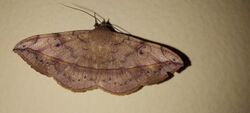Biology:Anticarsia irrorata
| Anticarsia irrorata | |
|---|---|

| |
| Scientific classification | |
| Kingdom: | Animalia
|
| Phylum: | |
| Class: | |
| Order: | |
| Family: | |
| Genus: | |
| Species: | A. irrorata
|
| Binomial name | |
| Anticarsia irrorata (Fabricius, 1781)
| |
| Synonyms | |
| |
Anticarsia irrorata, the owl moth, is a species of moth in the family Noctuidae.[1] It is native to the Old World tropics.[2]
Description
Its wingspan is about 40–46 mm. Palpi with third joint rather shorter than in the typical section. Male lack tufts on tibia. Hindwings with normal neuration in male, with no fold in inner margin. Antennae of male with bristles and cilia.[3] It is light brownish with darker areas distally. The forewing is marked with a diagonal line and a row of black dots. The hindwing has similar markings. The underside has lighter, brownish dots and a white spot.[1] The larva is light green. It has a dorsal line which is dark green with a yellowish center, and wider, spotted lines on either side. The spiracles are white with black edges. It moves in a looping motion.[2]

Ecology
Common food plants include species from many legume genera, including Cajanus, Cicer, Cyamopsis, Glycine, Lablab, Mucuna, Phaseolus, and Vigna. It has also been noted on the melon genus Cucumis, and grasses such as Andropogon, Oryza, Paspalum, and Saccharum.[2]
References
| Wikimedia Commons has media related to Anticarsia irrorata. |
- ↑ 1.0 1.1 Anticarsia irrorata, Owl Moth. Cook Islands Biodiversity Database. The Cook Islands Natural Heritage Trust.
- ↑ 2.0 2.1 2.2 Anticarsia irrorata. The Moths of Borneo
- ↑ Hampson, G. F. (1894). The Fauna of British India, Including Ceylon and Burma: Moths Volume II. Taylor and Francis. https://www.biodiversitylibrary.org/item/180400#page/5/mode/1up.
Wikidata ☰ Q4774593 entry
 |

